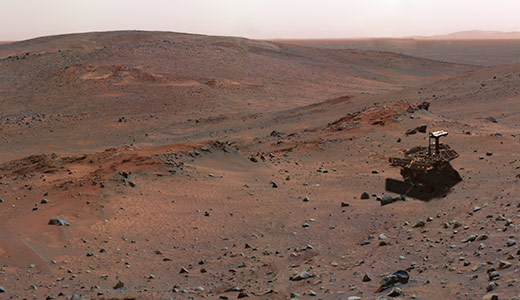What would you say if someone approached you and offered you an extended stay in a barren wasteland of sand, mudstone and rock? You’d be heading to a foreign place where the temperature averages out to somewhere around 50 degrees below zero. A vacay away, let’s say, but with no palm trees or rolling oceans … or air—the atmosphere being made up largely of carbon dioxide. Oh and what if that smiling promise of bleak barrenness was also a one-way trip? You’d head out with no salary, no cell phone, no social media connection, and with no chance of ever returning home to family and friends.
Don’t laugh, it’s real. Or, at least, that’s what they’re telling us.
The coordinators of a private space-going program called Mars One tossed out that, uh, tempting offer to the public at large and 200,000 people from around the world instantly jumped at the possibility. Yes, 200,000 eager souls whose numbers were then whittled down to the now just-announced 100 finalists—on the way to finding a smaller group that might be as small as four lucky folks who will take that ultimate step on the surface of the planet Mars.
Bas Lansdorp, 37, conceived the Mars One non-profit venture when he was an engineering student at the University of Twente in the Netherlands. He’s been working on it ever since—gathering the right experts for his advisory board and penning a partnership deal with Lockheed Martin—and he’s certain they will land at least two men and two women on that mysterious orb by the year 2025. After all, as he sees it, the technology needed to reach and colonize the Red Planet in artificial podlike habitats already exists, so why not go ahead and get the sci-fi-sounding show on the road. (“Mars Colony” and the year “2025” do sound like they were plucked straight out of an old Paul S. Newman comic, don’t they?)
People have been talking about setting foot on the red planet for years. And this isn’t the first time a trip to Mars has been considered—from an official NASA endeavor to a trip sponsored by tycoon Sir Richard Branson’s Virgin Galactic. But there’s one advantage that Lansdorp and company have that the others never thought of: Reality TV!
Lansdorp announced that they want to make the entire process an “ongoing global media event” in order to draw in the gazillions of dollars needed for the project. So that’s why the current roster of 100 astronaut hopefuls covers a pretty broad range of attractive and interesting people. The equally divided group of men and women span a variety of ages (from 19 to 60) and geographical locales ( 36 different countries), and individual skills run the gamut, too, from astrophysics to stand-up comedy.
When you look at it from that perspective, it feels like this thing could well be a winner. Hey, what other reality TV show might possibly let you watch as a clown and a scientist go through training trials, find love and then crash land on the surface of Mars! Now that’s TV.
Of course, we can only hope that if this project really does take flight, the Mars One crew will be thinking more about safety and solid tech than ratings. Even if those nutty cast members are willing to give up everything for a little TV time and a patch of dusty Martian dirt, their lives will be at risk if they ever really do reach the launch pad.
I mean, this is rocket science we’re talking about.






Recent Comments